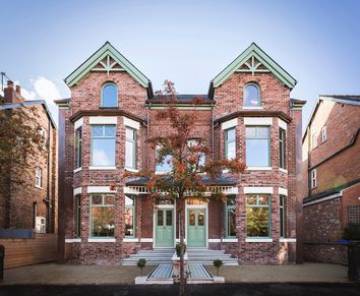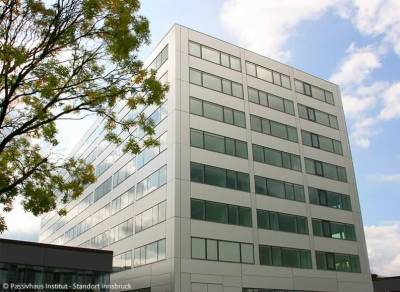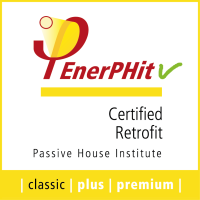Table of Contents
EnerPHit: The Passive House Standard for retrofits
It is not always possible to achieve the fulll Passive House Standard for refurbishments of existing buildings (introductory article), even with adequate funds. For this reason, the PHI has developed the EnerPHit Standard – Energy Retrofit with Passive House Components - as quality assured certification scheme for renovation of existing buildings. It can be applied on one go, or as a phased approached using the EnerPHit retrofit plan. Details on the EnerPHit Standard itself are outlined below.
Bigger picture context, why deep energy retrofits are important:
EnerPHit building renovation: Highly efficient building renovation as a societal no-regret measure
Significant heating/cooling energy savings of between 75 and 90 % can be achieved even in existing buildings, for which the following measures have proved to be particularly effective [Bastian 2022]. The general approach to prevent lock-in and achieve high quality cost-effective solutons is: If you do it, do it right!
- Improved thermal, similar to Passive House newbuild levels
- Considerably improved airtightness
- Use of high quality windows: Use of Passive-House-suitable windows whenever the opportunity arises.
- Ventilation with highly efficient heat recovery. Again, aligned with Passive House newbuild efficiency recommendations
- Efficient heat generation
- Use of renewable energy sources. Depening on use of renewable energy, EnerPHit is also availble as certification classes Classic, Plus and Premium.
These are exactly the same measures that have proven to be successful for new constructions. A number of examples demonstrating the application of high-efficiency technology in existing buildings are available, including monitoring data as proof of concept of the achieved energy savings. You can find examples of implemented EnerPHit buildings in the online Passive House Database (advanced search, filter by Energy Standard / building type for EnerPHit projects).
The EnerPHit Standard
The EnerPHit standard can be reached by meeting energy demand performance limits or, alternatively, by meeting minimum efficiency performance levels for individual building components. Depending on the project, these two approaches allow flexibility to implement a retrofit concept that makes the most sense economically and ecologically, whilst ensuring a high level of efficiency and thus preventing energy lock-in. For the component method, individual components must achieve minimum efficiency values similar to the requirements for certified passive house component certification. The energy demand method is similar to the Passive House newbuild standard, but with slightly higher target values to allow for the special challenges of retrofitting existing buildings.
A stepped or phased retrofit allows for a gradual improvement of a building's energy efficiency, with costs and effort spread over time. The EnerPHit Retrofit Plan (ERP), which is based on the PHPP balancing tool, is a very valuable tool for planning and coordinating the various retrofit steps.
To learn more about the EnerPHit-Standard we recommend visiting the following section in the Passive House Institute's website and take a look at additional resources listed below.
 |  |
| Example certified EnerPHit Plus project in Manchester, UK. Find out more in the project database: ID: 5807 | Examle certified EnerPHit universtity building in Innsbruck, Austria. Find out more in the project database: ID: 4200 |
Literature
[Bastian 2022]: Bastian, Z., Schnieders, J., Conner, W., Kaufmann, B., Lepp, L., Norwood, Z., Simmonds, A., Theoboldt, I.: Retrofit with Passive House components. Energy Efficiency 15, 10 (2022). https://doi.org/10.1007/s12053-021-10008-7. The article can be read online here.
See also
Landing page on refurbishments of existing buildings
Overview of Building Certification
EnerPHit building renovation: Highly efficient building renovation as a societal no-regret measure
1.3 EnerPHit criteria for basements and building components in contact with the ground
Factors that influence the energy balance and affordability of non-residential EnerPHit projects ![]()
International EnerPHit Certification Criteria for Energy Retrofit with Passive House Components ![]()
Further publications on Passipedia related to EnerPHit
Passive House in the existing building stock
Fact sheets:
